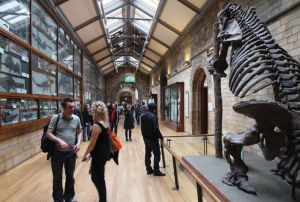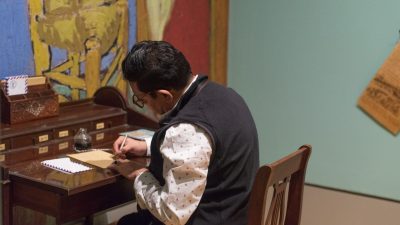This article originally appeared in the July-August 2016 issue of Museum magazine. First issued in 2016, the white paper was updated in 2019 to reflect the updated FASB accounting standard that allows for direct care as well as acquisition.
Disposal of collections through sale, trade or research activities is solely for the advancement of the museum’s mission. Proceeds from the sale of nonliving collections are to be used consistent with the established standards of the museum’s discipline, but in no event shall they be used for anything other than acquisition or direct care of collections. —Code of Ethics for Museums, American Alliance of Museums
Arboreta, Botanic Gardens and Public Gardens

Arboreta, botanic gardens and public gardens have living plants and specimens under their care; other types of museums (such as zoos, sculpture gardens, historic sites and nature centers) often do as well. Living populations have different and more specialized needs regarding their care and welfare; the acquisition, transfer and disposition of certain plants (e.g., rare, threatened or endangered) are governed by local, state, federal and international laws, regulations and conventions. The American Public Gardens Association (APGA) has developed Invasive Plant Species Voluntary Codes of Conduct (2002). APGA’s Plant Protection Program, which includes the Sentinel Plant Network, reinforces regulations restricting the transfer of potentially threatening pests or diseases. APGA is beginning work on a code of ethics for curators of living plant collections.
When writing a collections management policy, a museum with living plants and specimens should address the issues of threatened and endangered species, invasive species and plants acquired from foreign countries. Gardens that conform to the principles of the Convention on Biological Diversity and laws governing equitable sharing of benefits derived from utilizing plants from other countries should note that best practice includes documented informed consent of mutually agreed-upon terms and use of a material transfer agreement between institutions. Because these museums have the special ability to propagate either sexually or clonally items in their collection, they should consider including a statement clarifying whether the resulting progeny can be traded with/donated to other gardens or sold. If the progeny can be sold, they should state how the proceeds from sales may be used. Using such proceeds for purposes other than direct care of collections is a generally accepted practice.
Some arboreta, botanic gardens and public gardens have living animals as well as nonliving items in their collections (e.g., books, herbarium collections, art or historic structures listed on state or national registers). Their collections management policies should state whether these living populations and nonliving items are part of the organization’s permanent collection and address how proceeds from the sale of deaccessioned nonliving collections may be used.
Introduction
This white paper examines the phrase “direct care of collections” as used in the American Alliance of Museums’ (AAM/the Alliance) Code of Ethics for Museums regarding the use of funds realized from the sale of items deaccessioned from a museum’s permanent collections.
The white paper:
- summarizes the history behind the code of ethics’ use of the phrase “direct care of collections”
- reviews the ethical principles regarding responsible governance and collections stewardship
- provides guidelines and recommendations concerning direct care and guidance for museum staff and governing authorities in their decision-making
- recommends strengthening collections management policies regarding use of funds from deaccessioning
Art Museums

The Association of Art Museum Directors’ (AAMD) Professional Practices in Art Museums (2011) states, “Funds received from the disposal of a deaccessioned work shall not be used for operations or capital expenses. Such funds, including any earnings and appreciation thereon, may be used only for the acquisition of works of art in a manner consistent with the museum’s policy on the use of restricted acquisition funds.”
When writing their collections management policy, art museums should state how proceeds from the sale of deaccessioned items may be used.
Background
The AAM Board of Directors adopted the Code of Ethics for Museums in 1993, after several years of discussion and debate about how museums should use funds realized from the sale of deaccessioned collections. An earlier version adopted in 1991 restricted “the use of proceeds from the sale of collection materials…to the acquisition of collections.”
Nearly three-quarters of museums objected that this restriction was excessively limiting and an impediment to fulfilling their respective missions. History and natural history museums in particular argued that a museum’s responsibility to care for and preserve its collections is of equal importance to its obligation to build its collections. Historic sites agreed, calling attention to the need to preserve buildings and landscapes as part of their collection stewardship responsibilities. Science and technology centers were shifting their focus to public education through interactive exhibitions not dependent on collections; some divested themselves of collections and did not plan to acquire more.
The issue became such a flashpoint that after six months, the 1991 Code of Ethics for Museums was suspended to allow for further discussion. Ultimately, in 1993, the AAM Ethics Commission recommended and the board of directors approved a revision stating that proceeds from the sale of nonliving collections should not be used for “anything other than the acquisition or direct care of collections.” The phrase “direct care of collections” reflected a compromise that would accommodate different disciplines and professional practices among museums. The phrase was not defined at the time because its definition was expected to evolve through practice and to be codified in individual museum collections management policies. The Ethics Commission meeting minutes and correspondence made it clear, however, that the phrase was not intended to include operating costs (including salaries) or to imply that funds garnered from the sale of deaccessioned objects could be used as a remedy in a financial crisis.
Twenty years after it first appeared in the code of ethics, interpretation of the phrase remained problematic. AAM’s Accreditation Commission identified defining “direct care of collections” as a top priority. The commission found that because that term has never been defined or clarified, museums lack guidance in their decision-making and, consequently, standards often are applied inconsistently. In response, the Alliance Board of Directors appointed the Direct Care Task Force, charging it to work across disciplines to clarify appropriate practices for the field and reinforce the public’s confidence that museums are upholding their promise to present and future generations by caring for their incomparable resources.
To satisfy that charge, in 2015, the task force commissioned a field-wide survey to determine what museum professionals from different disciplines consider part of “direct care,” regardless of their museum’s current policies and practices. The more than 1,200 responses to the survey, which showed surprising consistency regardless of the respondent’s discipline or position within a museum, informed subsequent task force discussions about current practice and assisted the group in evaluating the principles underlying current standards and ethics.
In collaboration with key discipline-specific organizations, the task force reported its findings and recommendations to AAM and wrote this white paper to clarify the phrase “direct care of collections.” As the white paper addresses all disciplines represented in museums, its recommendations are general in nature. This approach allows each museum to tailor its application of “direct care of collections” to its particular discipline and circumstances.
The Alliance issued this white paper to the museum field in 2016, with deep appreciation to the task force for its thoughtful work.
Children’s Museums

Children’s museums have an audience in common rather than a type of collection. Depending on its focus, a children’s museum may have permanent collections related to history, art, science or natural history, and it may care for living plants and animals. Some children’s museums do not have permanent collections but use educational collections instead.
The Association of Children’s Museums’ (ACM) Standards for Professional Practice in Children’s Museums (1992) states that a museum with a permanent collection should follow “commonly accepted museum standards” for objects in its care. When writing its collections management policy, the museum should follow AAM’s Code of Ethics for Museums as well as the ethical guidance relevant to the types of collections it holds.
Underlying Ethical Principles
Museums are educational organizations “grounded in the tradition of public service” and, as such, hold their collections for the public benefit. A museum’s mission determines the scope and focus of its activities, including collecting; defines its distinctive nature; and guides all aspects of its governance, decision-making and operations. In spite of their individuality, most museums use objects—animate and inanimate, owned and borrowed—to engage and educate their audiences; this feature distinguishes museums from other organizations.
Collectively, museums share a responsibility for collections stewardship that “entails the highest public trust and carries with it the presumption of rightful ownership, permanence, care, documentation, accessibility and responsible disposal.” Museums acquire items of cultural or scientific value for their collections through donation, purchase, rescue or field research and hold these items for the benefit of present and future generations. Although these items may have a monetary value, once they become part of a museum’s permanent collection, that value becomes secondary to their importance as a means to enhance understanding of our world and ourselves. Consequently, museum collections are considered cultural—not financial—assets, to be held for the public benefit.
A museum’s governing body determines the organization’s policies and “protects and enhances” the diverse resources—physical, human and financial—needed to accomplish its mission. If a museum experiences financial difficulties, its governing body must make decisions that are consistent with its mission and its obligations to the public with regard to collections stewardship. It should ensure that funds realized from the sale of deaccessioned objects are never used as a substitute for fiscal responsibility.
Many museum collections contain objects that may no longer have relevance to the museum’s mission. All too often, they remain in the collection, using up space and institutional resources. For this and other reasons (e.g., when items are considered redundant, are damaged beyond repair or are of poor quality), deaccessioning is both a logical and responsible collections management practice.
The decision to deaccession items should be guided by the museum’s collections management policy, which should be approved by its governing authority, be in accord with standards for the museum’s discipline and detail a deliberate and careful decision-making process. In addition, the process of deciding whether to deaccession an object should be separate from the determination of the means for its disposition, as well as from the process of deciding how to use the proceeds from its sale. In no event should the potential monetary value of an object be considered as part of the criteria for determining whether or not to deaccession it.
By adhering to these ethical principles, museums demonstrate that they uphold the highest professional standards regarding the care of their collections. They also demonstrate that they maintain their holdings for the benefit of present and future generations, thereby encouraging public confidence and respect.
History Museums and Historic Sites
History museums and historic sites frequently have extensive and diverse collections that may include objects, fine art, libraries, archives, historic buildings and cultural landscapes. These organizations often have a greater need for funds to care for collections than for acquiring them. The American Association for State and Local History’s (AASLH) Statement of Professional Standards and Ethics (2012) states that these historical resources shall not be used to “provide financial support for institutional operations, facilities maintenance or any reason other than preservation or acquisition of collections, as defined by institutional policy.”
A history museum or historic site should determine whether all or some of its historic structures and landscapes will be treated as part of its collection; if so, they should be designated accordingly in the collections management policy. Because the distinction between building maintenance and preservation is easily blurred, the museum should thoughtfully delineate the two in its policy and practices.
Guidelines and Recommendations
Definition
According to the AAM Code of Ethics for Museums, funds realized from the sale of deaccessioned items may be used only for “acquisition or direct care of collections.” Thus, when an object is sold, the funds generated should be used to either:
- replace the object with another that has relevance, importance or use to the museum’s mission (acquisition)
- invest in the existing collections by enhancing their life, usefulness or quality and thereby ensuring they will continue to benefit the public (direct care)
Disciplinary Differences
Museums represent a range of disciplines, from art and history to the sciences. As a result, they have different responsibilities, practices and terminology regarding the acquisition, care and disposition of their collections, depending upon the kind of objects or living populations they hold. The AAM Code of Ethics for Museums states, “Proceeds from the sale of nonliving collections are to be used consistent with the established standards of the museum’s discipline….” For example, the Association of Art Museum Directors’ Professional Practices in Art Museums allows funds to be used for acquisition only. Zoos, aquariums, botanical gardens and some other types of museums are stewards of living populations and have more specialized concerns regarding the “direct care” of their animals and plants. The American Association for State and Local History (AASLH) uses the term “preservation” instead of “direct care.” The sidebars provide further discipline-specific commentary and guidance about the principles of direct care.
Natural History Museums

Natural history museums often have collections that are governed by state, federal and foreign laws and regulations regarding acquisition, transfer of ownership and disposition. These museums frequently acquire new objects or specimens through field collecting or excavation expeditions. In many instances, their deaccessioned objects or specimens cannot be sold.
When writing its collection management policy, a natural history museum should note whether it uses field collecting and/or excavation as a method of acquiring objects or specimens. If so, this work would be considered “acquisition” under AAM’s Code of Ethics for Museums regarding use of proceeds from the sale of deaccessioned items.
Creating an Institutional Policy
To ensure consistency and promote accountability, each museum should include in both its own code of ethics and its collections management policy identical statements on the use of funds from deaccessioning, limiting use to new acquisitions and/or the direct care of existing collections.
If a museum allows proceeds from deaccessioned collections to be used for direct care, AAM recommends that the museum’s collections management policy articulate the process and criteria that will determine that use. Analogous to statements regulating acquisitions and deaccessioning, the policy should spell out:
- the scope of “direct care of collections,” drawing on the ethical principles underlying direct care of collections as well as the ethics and standards of the museum’s discipline
- the process the museum will follow to determine how funds will be used
- the key members of the professional staff (collections, curatorial, management and leadership) and governing authority who should be involved in making the decision.
The Alliance recommends that a museum’s governing authority place the funds realized from the sale of deaccessioned objects in a segregated or identifiable account. In keeping with the spirit of the ethical principles related to deaccessioning and use of funds, the Alliance also recommends that the earnings on this segregated or identifiable account be used only for acquisition or direct care. These practices should be stipulated in a museum’s collections management and financial policies.
Decision-Making Tools
The 2015 field-wide survey commissioned by the Direct Care Task Force provided a useful snapshot of attitudes on the issues of direct care and acquisition costs.11 While the survey revealed a consensus that funds should be used strategically to enhance the collections and not to fill budgetary gaps, a number of potential uses fell into a gray area. Use of funds for some purposes seems more or less acceptable as “direct care” depending upon a museum’s mission, discipline and specific circumstances.
The task force developed two tools—a matrix and guiding questions—to help museum staff and governing authorities determine if a particular use of funds realized from the sale of deaccessioned objects is appropriate as “direct care of collections.” All decisions must be made in accordance with relevant state, federal or international laws and regulations, as well as with discipline-specific guidance and any donor-imposed restrictions.
Science/Technology Museums/Centers
Science/technology museums/centers may have accessioned nonliving collections, and they sometimes care for live animals. Their nonliving collections typically are history and/or natural history objects or specimens. These museums should follow guidance provided in this paper’s sidebars for the specific types of collections they hold.
When writing a collections management policy, science/technology museums/ centers should delineate between objects and live animals that are accessioned into the permanent collection and those that are for hands-on educational use. They should note if they are abiding by other professional ethics in addition to AAM’s Code of Ethics for Museums (e.g., those issued by AASLH or the Association of Zoos and Aquariums).
Matrix
The matrix on page 40-41 reflects criteria that the task force developed based on concerns expressed in the code of ethics debates in the early 1990s and responses to the field-wide survey. Together with answers to the guiding questions that follow, plotting a proposed expenditure on the matrix can be used to determine if the use of funds is appropriate.
On the horizontal axis, indicate where the expenditure falls between the following criteria:
- making a physical impact upon an object(s) that increases or restores its cultural or scientific value, thus prolonging its life and usefulness (e.g., conservation treatment; restoration of an object; preservation/restoration of an interpreted historic structure that is treated as part of the collection)
- making an institution-wide impact that benefits areas or operations of the entire museum, not just those associated with collections (e.g., salaries; preservation/restoration of historic structures or landscapes that are not interpreted to the public and are not treated as part of the collection) On the vertical axis, indicate where the expenditure falls between the following criteria:
- a strategic investment consistent with responsible fiscal planning and adequate planning for collections; an expense not normally considered part of the museum’s operating budget
- a quick fix or Band-Aid used to fill budgetary gaps; not directly related to collections care; routine operating cost; regular maintenance
The quadrant in which the two points intersect indicates whether the expenditure is appropriate.
- Quadrant One: the expense is considered direct care of collections.
- Quadrants Two and Three: the expenditure is in a gray area. The decision should be carefully considered against the ethical principles underlying direct care of collections as well as the existing ethics and standards of the museum’s discipline. Use of funds that falls in these quadrants is more acceptable if it makes a strategic investment in collections care.
- Quadrant Four: the expense is not an acceptable use of funds.
Guiding Questions
The following questions also may guide discussions and decision-making, with “yes” answers indicating a “direct care” action:
- Will this investment enhance the life, usefulness or quality of an object(s)?
- Is this a strategic decision based, for example, on an institutional plan, a collections care plan or a conservation assessment?
- Will the expenditure have a physical impact on an item(s) in the collections?
- Will this investment improve the physical condition of an item(s) in the collections rather than benefit the operation of the entire museum?
- Is this decision being made without pressure resulting from financial distress at the museum or parent organization?
- Is this a cost that is not normally considered part of the museum’s operating budget?
- Can this decision be clearly explained to the museum’s stakeholders and the public?
Zoos and Aquariums

Zoos and aquariums have living animals and specimens under their care; other types of museums (such as natural history museums, nature centers and living history farms) sometimes do as well. Living populations have different and more specialized ethical considerations and needs regarding their care and welfare. In most cases, their acquisition, transfer and disposition also are governed by local, state, federal and international laws and regulations. The Association of Zoos and Aquariums’ (AZA) Code of Professional Ethics (1976) addresses a member’s “moral responsibilities…to the animals under my care” and specifically requires members to “make every effort to assure that all animals…do not find their way into the hands of those not qualified to care for them properly.” Several policies expand the interpretation of the AZA Code of Professional Ethics; most relevant here is the AZA Policy on Responsible Population Management (2016). The detailed policy addresses wild, feral and domestic animals.
AZA acknowledges that nonmembers are not required to follow its Code of Professional Ethics. Non-AZA members with animals and specimens under their care should state in their collections management policy whether they abide by the AZA professional ethics and policies.
Many zoos and aquariums own nonliving items, such as art or historic structures listed on state or national registers. Their collections management policies should state whether these items are part of the organization’s permanent collection and address how proceeds from the sale of deaccessioned nonliving collections may be used.
Conclusion
The practices surrounding deaccessioning and disposition of objects from collections are routine for the museum field, yet the phrase “direct care of collections” regarding the use of proceeds from deaccessioning has been problematic since it was introduced in 1993. This white paper clarifies the ethical principles involved in direct care of collections and frames the issues that each museum will need to consider as it develops policies and processes to guide decision-making. AAM believes that the recommendations in this white paper will create a more coherent approach to the use of funds realized from the sale of deaccessioned objects across all disciplines represented in museums. Further, the Alliance encourages museums to foster transparency by explaining to their stakeholders any use of funds generated from collections. As a result, the field as a whole and museums individually will demonstrate more clearly how they uphold their stewardship responsibilities for the benefit of the public.
The Alliance collaborated with key discipline-specific organizations to identify individuals to represent a variety of perspectives on the Direct Care Task Force. The Alliance expresses deep gratitude to the following task force members for their thoughtful and inclusive process.
- Sally Yerkovich (chair), director, Institute of Museum Ethics; faculty, M.A. museum professions program, Seton Hall University, and museum anthropology program, Columbia University
- Kathy Kelsey Foley, director, Leigh Yawkey Woodson Art Museum
- Sarah George, executive director, Natural History Museum of Utah
- Patty Gerstenblith, distinguished research professor and director, Center for Art, Museum and Cultural Heritage Law, DePaul University College of Law
- Ron Kagan, director, Detroit Zoo
- Lisa Yun Lee, director, School of Art and Art History, University of Illinois; American Alliance of Museums board member
- Burt Logan, executive director and CEO, Ohio History Connection; chair, Accreditation Commission
- Thompson M. Mayes, vice president and senior counsel, National Trust for Historic Preservation
- Laurie Norton Moffatt, director and CEO, Norman Rockwell Museum
- David Rock, director of exhibits and collections management, Arizona Science Center
- Stacey Swigart, curator of collections, Please Touch Museum
- Tim Thibault, curator, woody plant materials, Huntington Library, Art Collections and Botanical Gardens
- Ken Turino, manager of community engagement and exhibitions, Historic New England
- Janet Vaughan, vice president, membership and programs, American Alliance of Museums
- Julie Hart, senior director, standards and excellence programs, American Alliance of Museums
The Alliance is grateful to the Association of Art Museum Directors (AAMD), the American Association for State and Local History (AASLH), the Association of Children’s Museums (ACM), the American Public Gardens Association (APGA), the Association of Science Museum Directors (ASMD), the Association of Science-Technology Centers (ASTC), the Association of Zoos and Aquariums (AZA) and the Society for the Preservation of Natural History Collections (SPNHC) for their collaboration on this effort.









Comments